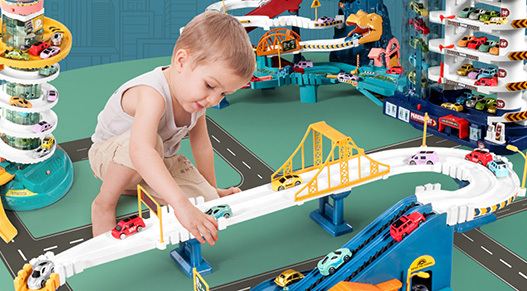Toys play a significant role in the growth and development of children in several ways. They help in enhancing cognitive skills, promoting creativity, and improving motor skills. Through play, children learn to solve problems, develop social skills by interacting with peers, and express their emotions. Additionally, toys can stimulate imagination and encourage exploration, which are crucial for a child's overall development.
Release time:
2024-12-11
The significance of structural games with children's toys mainly lies in the ability of young children to build various objects or buildings, which promotes the development of thinking and the habit of hands-on operation. This aims to integrate hand and brain usage. During the process of using various materials, children can directly understand the properties of different substances.
The significance of structural games with children's toys mainly lies in promoting the development of thinking and the habit of hands-on operation through the construction of various objects or buildings by young children. This aims to achieve the goal of using both hands and brain. In the process of using various materials, children can directly understand the properties of different substances, recognize the shapes and quantities of various materials, and gain knowledge and experience in applying various materials in structures. Additionally, children's design and conceptual abilities can also be exercised. For example, building blocks need to be stacked piece by piece, layer by layer, to construct a building or a reservoir, and success can only be achieved after multiple failures, which is a good way to train children's willpower.
Toys are the angels of children. Why is that? In the process of young children understanding the surrounding world, toys play a significant role. Toys attract children's curiosity and attention with their bright colors, beautiful and unique shapes, dexterous movements, and pleasant sounds. Toys are concrete objects that resemble real-life images, satisfying children's desire to manipulate and play with objects. The variety of toys and the diversity of play methods can spark children's interest. Good toys can stimulate children's desire to play games, serve as textbooks for their learning, and are also their beloved companions in life.
Children's toys can stimulate children's enthusiasm for activities.
The development of a child's body and mind is realized through activities. Toys can be freely manipulated, operated, and used by young children, aligning with their psychological preferences and ability levels. They can meet their activity needs and enhance their enthusiasm for activities. For example, with a "rocking horse" toy, children will naturally ride on it and sway back and forth, satisfying their activity requirements while generating positive and joyful emotions, thus they can play for a long time without getting bored. Similarly, "doll" toys can inspire children to engage in various activities, allowing children of different ages to play with dolls based on their life experiences, ranging from simple to complex and varied.
Children's toys can enhance perceptual understanding.
Toys have the characteristic of being visually intuitive, allowing young children to touch, hold, listen, blow, and see, which is beneficial for training various senses. For instance, colorful stacking rings, blow-molded toys, various dolls, and toy animals are beneficial for visual training; xylophones, small pianos, tambourines, and small trumpets can train hearing; building blocks, stacking pieces, and structural models can develop spatial perception; various puzzles, inlay toys, and soft plastic toys can exercise tactile sensations; pull-along duck toys, push toys, tricycles, and bicycles can help develop motor skills. While toys develop sensory and motor abilities, they also enrich children's perceptual knowledge and help consolidate the impressions gained in life. When children have not had extensive contact with real life, they come to understand the world through toys.
Children's toys can trigger associative activities in young children.
For example, hospital toys and dollhouse toys can evoke children's associations with hospitals and families, prompting them to engage in creative role-playing. Some labor tool toys can inspire children to simulate labor activities such as planting trees, digging rivers, and building. Some toys are specifically designed for cognitive training, such as various board games and intelligence toys, which can enhance children's abilities in analysis, synthesis, comparison, judgment, and reasoning, cultivating depth, flexibility, and agility in thinking. Engaging actively in thinking and imagination activities, and expressing them through hands or other body movements.
For example, when playing with "stacking" toys, children need to conceive, imagine, and choose materials to achieve a set goal; assembling requires both hands-on and mental effort. When young children engage with toys, they may encounter difficulties that require them to rely on their own strength to overcome and persist in completing tasks, thus cultivating the excellent qualities of overcoming difficulties and striving for progress.
It helps cultivate a sense of collective awareness and cooperative spirit.
Some toys require children to use them together. For example, "telephone" toys require both parties to communicate, and even a switchboard operator, which can help children understand and learn life experiences, practicing cooperation with peers. Similarly, "long rope" toys inherently require many children to use them collectively. In the game of jumping rope, children coordinate their movements, enhancing their sense of collective awareness.
Related News
Telephone:+86-754-86296861 Email: hongqi@hqtoys.cn
Address: Guanmei Industrial Zone, Longdu Town, Chenghai District, Shantou City, Guangdong Province







